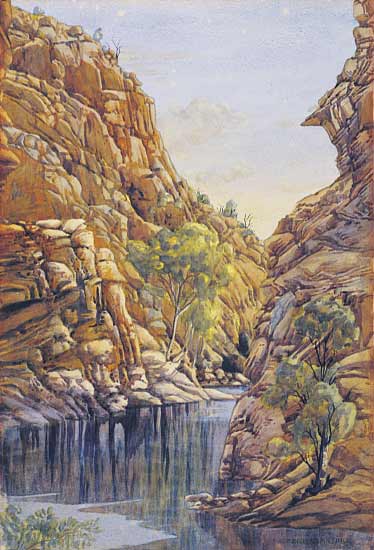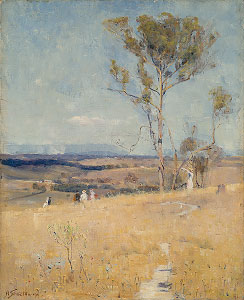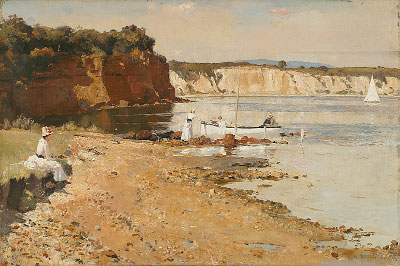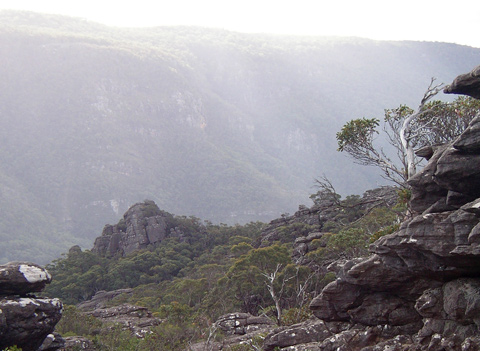MONASH UNIVERSITY
SCHOOL OF COMPUTER SCIENCE AND SOFTWARE ENGINEERING
HONOURS YEAR, COMPUTER SCIENCE
CSE450 : Procedural
modelling, animation
& artificial life in computer graphics
Assignment Notes
| Title
: |
The Australian
Landscape
|
| Date
Due: |
Refer
to
main page |
| Weight: |
100%
of your final mark for this unit |
| Submission: |
CD-ROM |
Specifications:
Landscape
has played an important part in Western Art over the last few centuries and
in Eastern Art over many centuries
prior. In Australia, our culture, both indiginous and colonial, has been
inseparably linked to the unique landscape within which we find ourselves.
The aim of this project is to produce your own animated Australian landscape
image, influenced by the
samples
illustrated
below.
|
|
|
|
Albert
Namatjira
The Finke River Gorge at entrance to Glen Helen c.1945-53
Watercolour & gouache over pencil on thick wove paper. Queensland
Art Gallery
|
Arthur STREETON
Near Heidelberg 1890
oil on canvas
Felton Bequest, 1943. Ian Potter Centre: NGV Australia
|
Tom
ROBERTS
Slumbering sea, Mentone 1887
oil on canvas. Ian Potter Centre: NGV Australia |
Alan
DORIN
The Grampians, 2005
Digital Photograph
(Insert your own photograph here - see below) |
Adapt the techniques
discussed in lectures to model the landscape in one of the images above.
If you have taken a photograph of the Australian landscape that you
would like to use as a model, you may do so. Please show the image to the
lecturer for his approval
before proceeding.
You might consider
using a fractal technique to model rocks and mountains, a graftal
or
L-system
to
model the
trees, and
a Cellular
Automata
model to
animate
ripples on the water. Perhaps particle systems or procedural texturing
could be employed to generate grass and a simple noise pattern textured onto
a
sky-dome
to make clouds or moving mist. The image you select will to some extent
determine the most suitable modelling techniques. For the best effects,
carefully choose your colours (sample them from your chosen image) and lighting
(consider the time of day, position and effective colour of the sun, as well
as the relative amounts of direct sunlight and ambient
or diffused light).
All your
code should be written in C or C++ and should run under a UNIX (or derivative)
operating system. It should produce a numbered sequence of model files for
rendering. Visualize your animated model by rendering the sequence of model
files using a stand-alone free/share-ware renderer such as POV-Ray.
(It is worth scanning the POV-Ray gallery and Hall-of-Fame for ideas on how
to use the modelling primitives the software can handle to generate landscapes
containing
rocks,
water, skies, light sources etc. Note that you will only be marked on phenomena
that you have modelled yourself. For instance, if you use the POV-Ray noise
generator as a texture, you will not receive marks as if you had implemented
the noise generator yourself. You may still receive "bonus" marks for the
final look of your images as indicated below.) Use a free/share-ware package
to assemble your still frames into a Quicktime or
AVI movie file.
There is no need to make your animation images very large. As long as everything
is clearly visualized small file sizes are welcome!
The marking guide below is not
meant to be prescriptive. Choose the features of an image above that most
interest you and model them as appropriate.
You will need to research modelling techniques. This will involve
reading papers and books, not just the WWW and the lecture notes. Prepare
a bibliography document detailing the references you have consulted in the
course of your research. Write a paragraph describing the contents of each
reference
you
have consulted. The paragraph should be specific about what the reference
contained that was of value (or not) for your assignment.
Marking breakdown:
| Stationary features:
rocks, mountains or eroded riverside |
[30%] |
| Animated features:
water, clouds, swaying trees etc. |
[30%] |
| Extras:
(be creative) flocking birds, swarming flies, chimney smoke, sea spray,
lightning strikes |
[30%] |
| Bibliography:
should include annotations and evidence that you have visited a library |
[10%] |
| Bonus: the
best images may receive some bonus marks |
up to 5 |
Submission
Details:
The
assignment is due at the time specified on the main
page.
Submit
all of the files specified below on a CD-ROM clearly labelled with your
name and ID number. Submissions will be accepted at the General Office on
the ground floor of building 75 only.
You will
need to include the following in your submission:
- The complete source
code required to create the program(s).
- Makefile's
whose default targets build the executable.
- A movie file
(or two separate movie files if you prefer) showing the animated landscape.
- A
couple of still
images that show off the details of your work.
It is OK if the still images are taken from the animation, but you might
like to render them at a larger size than your animation if you feel that
the intricacies of your model are lost in the small animation frame sizes.
Documentation is important.
Marks are allocated within each section for the research you have done. Documentation
submitted should include:
- Information as to what
was completed. (1 paragraph at the most!)
- The annotated bibliography
(see above)
- Brief instructions
on how to run the program
- Adequate comments
in the source code
Each file of your source
code must contain the follwing at the top:
/*
* This software is the original work of <Your Full Name>. ID: <Your ID>
* This software is submitted in partial fulfillment of the
* requirements for the degree of <Your Degree>,
* Monash University
*/
You are encouraged to
consult reference material as widely as possible, but remember the
code you write MUST be your own work. Make sure you think about, and
understand, the processes involved rather than blindly copying the work of
others.
Please be realistic about
what you can achieve given the time constraints. Students invariably spend
far too much time on this assignment. As much fun as it is, any time above
50 hours would be better spent on other activities. (e.g. fishing in the
Monash pond)
Late assignments will
incur mark penalties according to the Fibonacci sequence multiplied by a lecturer-determined
scaling factor (eg 0.5, 1 or 100). An assignment that is one day late will
receive a one mark penalty multiplied by the scaling factor. Assignments two
days late will receive a 2 mark penalty, three days late, 3 marks, each multiplied
by the factor. The sequence is [1],1,2,3,5,8,13,21... (times the factor).
This applies for all days including public holidays and weekends so please
submit your assignments punctually!
[ CSE450
Home Page ]



